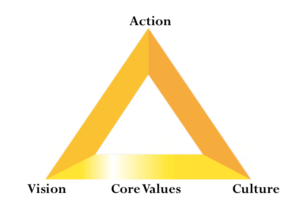The greatest ‘missing’ piece in recruiting and retaining associates isn’t contracting, benefits, CE, the best technology, profit sharing or stock offerings – although they all help. The greatest ‘missing’ is leadership.
But what does it really mean to be a leader? In our model of leadership we educate, develop and train leaders following the Golden Triangle of being a leader.
First, of course, is the vision. Vision in group practice requires you to clearly see where you choose to be in the future and to establish the necessary steps to get your practice there. Creating and sustaining a vision calls for strong discipline and creativity.
Creating a vision that is feasible is one side of the triangle of leadership. This includes articulating this vision to be heard by others; it must be clear so that people see the future you are articulating is possible. If the future does not seem possible, people will be unwilling to commit to make that future happen.
A leader must have the passion, strength of will and necessary knowledge to achieve long-term goals. A focused individual who can inspire his team to reach the practice goals and show how the practice itself will make a difference is a leader.
The second leg of the triangle is action. While a group practice vision represents the future it seeks to reach, action represents the steps taken to get there. Focus should be put into both vision and action. A balance is created when the milestones, goals and targets of getting to that future are crystal clear. Action should focus on what to do and how to get there with measurable and clear outcomes that are date-certain. Effective actions make your vision more realistic for associates.
The building blocks of the third leg of the triangle are core values. Core values that are not platitudes, clichés or bromides, but “commit-able” values. Without everybody dedicated to the same core values there is no real clarity in decision-making, what results in a heterogeneous under-performing culture and different perceptions of the company and each other.
That brings us to the third leg of the triangle, creating a culture where associates can realize their peak performance and take necessary actions towards achieving your vision. A culture is founded on “commit-able” core values. An enabling culture allows associates the freedom of creativity. A high-performance culture can be created and sustained by the language spoken and heard, which is part of the education we teach – and it works. Creating a high performance culture grounded in responsibility, accountability, authenticity, vulnerability, integrity, and making a difference is very achievable.

How Visionary Leaders Turn Vision into Reality?
Whenever a vision is followed by action, the vision can be turned into reality. One important action of leadership is the formation of a formidable team. No single skill set is sufficient in achieving success in business. A visionary leader recognizes talent and recruits associates with skills that complement each other and contribute to business growth.
Before any action can be turned into reality, a great deal of discipline is necessary. Discipline requires that you follow through with your word even in the face of obstacles and setbacks. This requires the leader to take responsibility for the associate’s actions and decisions.
If people fail to keep their word, a leader must take the necessary steps and correct or replace that individual. Vision, values and actions have no staying power nor can produce results without integrity, and integrity is giving and keeping your word.
A leader turns vision into reality by fashioning a tangible image for the associates’ objectives and targets, and by creating a specific plan for them to get there. The leader details what goals the company must accomplish and the specific responsibilities of each associate to achieve these goals. A leader keeps the associates informed of their goals and their performance toward attaining these goals through reports that are available to the entire team to see.
Visionary leaders have these three sides of the golden triangle in place, and keep them vibrant and alive. When a potential associate “feels” these are alive in the practice, recruiting is far easier and retention with results is more easily generated.



